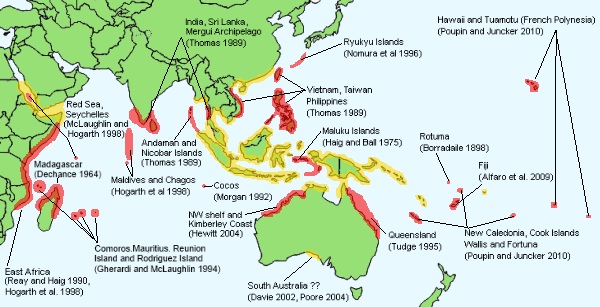Biogeographic distribution
Dardanus megistos is a widespread tropical to subtropical species associated with coral reefs across the Indian and west Pacific (Tudge 1995, Hogarth et al. 1998). It is known from the eastern coast of Africa (Tudge 1995, McLaughlin and Hogarth 1998) as far south as Madagascar (Dechancé 1964), the Comoros (Gherardi and McLaughlin 1994), the Mauritius (Gherardi and McLaughlin 1994), Reunion Island and Rodriguez Island (Gherardi and McLaughlin 1994) and including the coasts of Kenya (Reay and Haig 1990), Mozambique, Tanzania and Somalia (Hogarth et al. 1998). Its range extends into the Red Sea (McLaughlin and Hogarth 1998) and then, continuing across the Indian Ocean, it is known from the Seychelles (McLaughlin and Hogarth 1998), Chagos and Maldives (Hogarth et al. 1998), the Arabian Sea (Hogarth et al. 1998), including several islands off the western coast of India (Thomas 1989) and around the subcontinent to the Laccadives and the Gulf of Mannar, the east coast of India and Sri Lanka (Thomas 1989). Across the Bengal Sea it is then recorded from the Andaman and Nicobar Islands and the Mergui Archipelago off of Myanmar in the Andaman Sea (Thomas 1989). D. megistos is most likely widespread across Indonesia (Thomas 1989) and the coral triangle. Continuing northward, it is known from the coast of Vietnam (Thomas 1989), the South China Sea (Tudge 1995), the Philippines (Thomas 1989), Taiwan (Thomas 1989) and as far north as the Ryukyu Islands of Japan (Nomura et al. 1996).
Down through Indonesia, D. megistos is then known from the Maluku (Molucca) Islands west of New Guinea (Haig and Ball 1975) and the Cocos (Keeling) Islands (Morgan 1992), though interestingly is apparently absent from Christmas Island (Morgan 1992). Within Australia D. megistos occurs across the entirety of the Great Barrier Reef and extends south to reefs off of Moreton Bay, near Brisbane (Tudge 1995). It is also recorded from the north western shelf of Western Australia; the Dampier and Montebello Islands and the Kimberly Coast (Hewitt 2004). It is also apparently found from the coast of South Australia (Davie 2002, Poore 2004), though this seems questionable, is not well documented and hence should be taken most cautiously. In the Pacific its range extends as far as Hawaii and the Tuamotu Archipelago of French Polynesia (Poupin and Juncker 2010), with records also from Fiji (Alfaro et al. 2009), Rotuma (a northern Fijian dependency) (Borradaile 1898), New Caledonia (Poupin and Juncker 2010), the Cook Islands (Poupin and Juncker 2010), Wallis and Futuna (Poupin and Juncker 2010) and therefore most likely occurs across the remaining west Pacific archipelagos.
 |
|
Biogeographic distribution of Dardanus megistos. Red areas are those for which the primary literature confirms the presence of D. megistos and yellow areas represent suggested likely distribution. The records from South Australia seem unusual and should be treated with caution. Storm Martin 2012 |
|